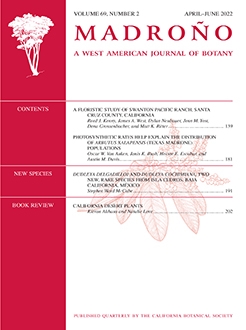Light response curves were generated using photosynthetic rates measured for mature canopy leaves and leaves from juvenile plants below the canopy of Arbutus xalapensis Kunth (Texas Madrone, Ericaceae) plants in central Texas. We hypothesize that understory juvenile plants will have higher photosynthetic rates at lower light levels and larger leaf areas; and saturate at lower light levels, lower light compensation points, lower dark respiration rates than canopy leaves. Plants were measured in a Juniperus ashei J. Buchholz/Quercus fusiformis Small (Ashe Juniper/Live Oak) hilltop woodland. In the area, A. xalapensis tree density was 2 ± 3 plants/ha x̄ ± 1 standard deviation) and basal area was 210 ± 190 cm2/plant. The photosynthetic flux density (PFD) on a clear sunny day at midday with sun at its zenith was 1870 ± 11 µmol/m2/s at the upper canopy edge; below the canopy light levels were 36 ± 4 µmol/m2/s, indicating the dense shade of the community. No differences were found in maximum photosynthetic rates (Amax), which were ∼ 16 µmol CO2/m2/s, between canopy and subcanopy leaves. Light saturation was slightly over 400 µmol/m2/s for both canopy and subcanopy leaves. Light levels below the canopy were 8.3% of the light saturation point of A. xalapensis, which means the plants were fixing carbon at less than 10% of their potential maximum rate. As indicated by light response curves, photosynthetic rates of leaves below the canopy or in light gaps would increase to the same level as canopy leaves, suggesting that recruitment in shade is possible for this species. However, leaves appear to be adapted to high light, having similar photosynthetic characteristics as high light canopy leaves, suggesting juveniles can respond to light gaps quickly in various community types.
How to translate text using browser tools
11 January 2023
PHOTOSYNTHETIC RATES HELP EXPLAIN THE DISTRIBUTION OF ARBUTUS XALAPENSIS (TEXAS MADRONE) POPULATIONS
Oscar W. Van Auken,
Janis K. Bush,
Hector E. Escobar,
Austin M. Davis
ACCESS THE FULL ARTICLE

Madroño
Vol. 69 • No. 2
April–June 2022
Vol. 69 • No. 2
April–June 2022
CO2 uptake
light compensation
light levels
light saturation
photosynthetic rates
respiration rates
shade plants




